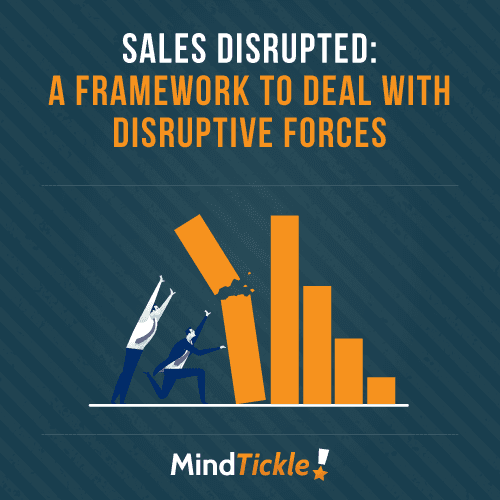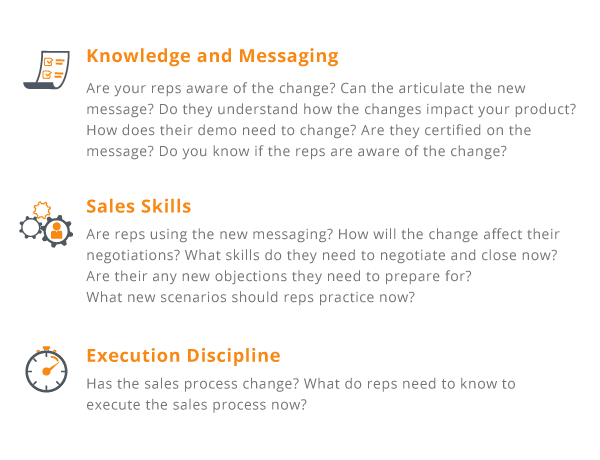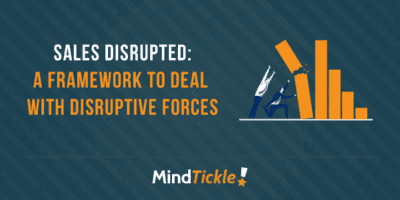We live in an age of constant change. An age where disruption is the new normal. But there are some events that can jolt your sales organization into a new phase instantly. And in an instant, you have to rethink your approach and adapt.

The disruptions that impact our customer’s most often include:
- Mergers and acquisitions
- Preparing to IPO and beyond
- A surprise new competitor
- Regulatory changes that impact how you sell
Perhaps your business has been part of a merger or acquisition or is preparing to IPO, a new competitor strategy has taken you by surprise, or a regulatory change has completely changed how you can sell. These significant events can take the
sales readiness of your sales organization
back a step or two and it can take you weeks, months or even years to recover and adapt. But that doesn’t mean you need to recreate the wheel every single time. By following or framework you can identify how your business needs to adapt and get back on track quicker.
A framework for enabling sales disrupted
The key to recovering from a sales disruption is to be agile. Your reps need to be enabled so they can pick themselves up and get back out there quickly. But speed alone isn’t enough if your reps aren’t prepared with the right things to get them back on track.
Before reacting, take a step back and look at
what parts of your business
the disruption is impacting:
- Resources: Do you have the right resources to take your business forward? This isn’t just about having enough salespeople, but also consider whether they’re all up to standard. Perhaps you need more support resources or different tools to help your sales organization be agiler.
- Processes: Do your processes meet the needs of your sales organization now? Your processes need to be agile enough to adapt or at least be reviewed when a disruptive change occurs. It’s also important to look beyond your sales processes and to any other business process that may be impacted like customer success or logistics to ensure that they also meet the needs of your new world order. The more stable and adaptable your processes are, the easier it will be for your business to react quickly to disruption.
- Values: Your corporate values flow through your entire organization, but how are they applied to your sales organization. Your sales reps need to have some autonomy to apply your values, but these need to first be communicated well so they are applied correctly. This can filter down to the type of business you wish to attract or how your reps react when faced with stiff price competition. Agile businesses empower their employees to act within their values.
Taking this approach one level down, you can then establish an enablement framework that considers the three areas where your reps may need support; Knowledge and Messaging, Sales Skills, and Execution Discipline.
Here are some questions you can ask yourself to help identify what enablement initiatives need to be in place.

What initiatives your sales organization needs the most will depend on what has caused the disruption to your business. For example:
Disruption #1: Mergers & Acquisitions:
The core objective here is to retain customers and maintain momentum through a period of internal change. Often knowledge and messaging is the most crucial focus area for enablement activities as reps require regular communication and the value proposition may need to be rebaselined.
Disruption #2: IPO:
As you prepare for IPO execution discipline is key, ensuring you have all your processes in place. Post-IPO this may shift to knowledge and messaging as communication becomes more important and the business’ messaging changes.
Disruption #3: Surprise competitor:
Knowledge and messaging are critical when going into battle with a new competitor. YYour value proposition needs to be sharp and your reps will need to be up-to-date with the competitive landscape and offerings.
Disruption #4: Regulatory changes:
– While knowledge and messaging is important, depending on the regulatory change, it may impact the sales process and the skills your reps require.
Put a plan in place
To drive your enablement program put in place milestones and a process to achieve these. For example, if you want to develop a consistent message across the organization, what’s the message? How will you communicate this? How will you know that it has been a success? Who will need to be involved in the process?
This plan will map not only what needs to be done, but also which stakeholders will be involved in each step and what other tools you need to achieve it.
Measure, measure, measure
Once you know what areas require focus you can then consider what insights you require. The closer you are able to monitor your reps progress, the quicker you will be able to identify any gaps in their knowledge or skills and plug them. This will keep any revenue leakage from the disruption to a minimum.
By focusing in on leading indicators of
sales effectiveness and efficiency
, rather than lagging indicators, the more control you will have over your revenue. For example, if your value proposition has changed then reviewing your reps’ elevator pitch will be important. Role plays can be used to provide coaching and feedback and certifications provide a mechanism to measure how prepared reps are for their customer conversations.
Dealing with disruption is never easy. Knee-jerk reactions are common, but they rarely have the desired effect. By following a structured approach you can ensure your sales reps are enabled to deal with the disruption quickly and confidently. Who knows, it may even put you in the position to outsmart the disruptive force.



 By Helen Waite
By Helen Waite

 By Rahul Mathew
By Rahul Mathew